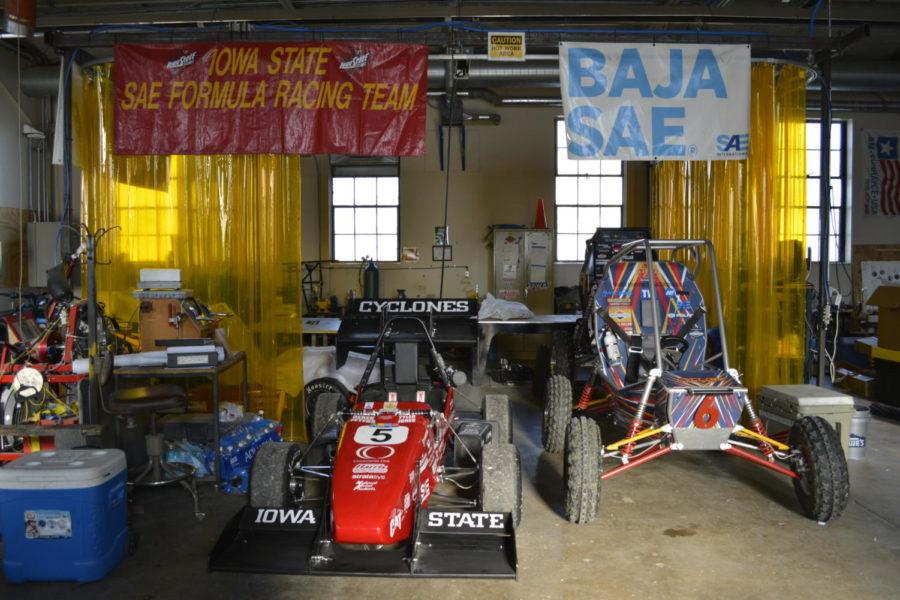SAE International make adjustments as they move into AMSL
Cars built by the Formula and Baja Society of Automotive Engineers teams are displayed in the Advanced Machinery Systems Laboratory.
September 6, 2017
Headquartered in the Advanced Machinery Systems Laboratory (AMSL), the Society of Automotive Engineers (SAE) student organization is dedicated to giving students the opportunity to get a hands-on experience in the process of building various mechanical machines.
“We actually have four different student organizations currently housed in the AMSL,” Joey Greco, president of the SAE International club here at Iowa State, and also suspension team lead for the Formula SAE team, said. “We share the AMSL with the robotics team, Cyclone Space Mining, PrISUm and then all five SAE teams: Aero, Baja, Clean Snowmobile Challenge, Formula and Supermileage.”
Walking through the laboratory space, one can see a plethora of tools, equipment and materials that the various SAE teams and PrISUm utilize to build their respective vehicles.
After the builds are completed, the teams compete against various other colleges from around the country, and sometimes, the world.
“The key with SAE competitions, to keep it competitive at all times, is that you have to change a certain percentage of your design every year,” Jason Whited said, vice president for the SAE club and team lead for the Baja SAE team. “So teams that reuse frames and suspension components have to change a majority of other parts, whereas when we [Baja and Formula] build our cars, we start from the ground up each year, allowing us to more easily follow that rule.”
The SAE teams follow a general trend of using computer-aided design software to build mock-ups of the car in the fall semester, and then begin assembling the full-size vehicle in the spring.
“On this workbench back here, that’s where the car really begins to take shape,” Greco said, pointing towards Formula’s specific work area. “It’s really cool to watch the frame get assembled because it starts off with just a bunch of metal lying around, and eventually, we have the whole thing welded together.”
Among the vehicles for Baja and Formula, there were also a few examples from the Aero, Clean Snowmobile and Supermileage teams.
The Aero team had built an RC plane entirely out of balsa wood, due to a rule that prohibited composites, Greco said.
Supermileage is in the process of reconstructing their vehicle, and the Clean Snowmobile is also being repaired.
As Whited was displaying the vehicles Clean Snowmobile had in the shop, he recalled getting a message about the Clean Snowmobile team while they were at a competition.
“I was doing some studying when I came across a picture of their competition going on, and I see a snowmobile had caught fire. I looked closer and unfortunately it was our team. I asked them about it later and they dubbed it a ‘thermal event,'” Whited said.
One thing Greco emphasized was the fact that these cars are designed and assembled entirely by students.
“For some stuff, and this goes for all SAE teams, we simply don’t have the equipment or ability to manufacture specific components. For example, our air intake system on the Formula car was 3D printed by one of our sponsors,” Greco said. “But other than that and a few other specialty parts, our cars are entirely student designed, built and driven.”
The SAE teams each have their own specific design challenges, but that doesn’t impact their willingness to work together and help each other out. Whited and Greco both explained that at the end of the day, it’s just a bunch of 18 to 23-year-olds making a vehicle that they feel passionate about.
In one corner sat the Clean Snowmobile Challenge, and right next to it was the workspace for both Formula and Baja. Greco explained that while each team has their own chemistry, they are willing to lend tools and a helping hand whenever it is needed.
“Our buzzwords are student led, student designed, student fundraised and student competed,” Greco said.
The Formula team saw recent success, as this past August, the Iowa State Formula SAE team was ranked 14th out of 540 scored teams from around the world.
Greco said this achievement was especially meaningful due to the fact that they were in the midst of moving from the late Nuclear Engineering building to AMSL.
“We have achieved the success we have because of some very knowledgeable people who put a lot of time into this program,” Greco said. “It’s a testament to how hard our students work to make something great. There were a lot of long nights that went into that car, but in the end, it was totally worth it.”
Greco encourages any student, regardless of major, to contact the SAE club if they have any interest in helping out.
“It’s far more than just building a car; it’s more of a business. We need people to help fundraise, market and advertise our car so that we can continue to see success with the program. We really have something for everyone,” Greco said.







